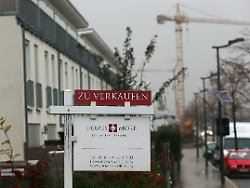Wednesday, December 8th, 2021
High housing costs partly excluded
There is a gap in Europe’s inflation statistics
An economist and an economist prove: Because the rising costs for owner-occupied residential property are not taken into account, the official European inflation rates in the past few years have been too low. That would not have changed anything in terms of monetary policy, but it is still problematic.
The suspicion is omnipresent: Is the “official” inflation rate correct? Have the prices in the supermarket, at the petrol station, in the pub and, above all, on the real estate market not risen much more than the inflation figures from the Federal Statistical Office and Eurostat, which have been far below the ECB target of “close to but below two percent” for years? In many areas it can be shown that this is deceptive and that the difference between perceived and actual inflation is based on a deception, for example because high price increases are particularly remembered, while falling or stable prices are less noticeable. An important cost item, which has become significantly larger for many Germans and Europeans in recent years, has so far not actually been taken into account in the relevant European inflation statistics, the Harmonized Index of Consumer Prices (HICP): the cost of owner-occupied residential property.
After all, almost half of Germans live in their own house or apartment. In many other European countries there are significantly more. While rents and their rise, which the other part of the population has to shoulder, are fully included in the inflation calculation, so far only a small part of the expenses for home ownership have been taken into account, for example for maintenance and minor repairs. The large cost block of the purchase price or the repayment of the corresponding debts, on the other hand, is neglected.
Like the economist Geraldine Dany-Knedlik and her colleague Andrea Papadia from the German Institute for Economic Research in a study show, the HICP has shown inflation rates that have been on average 0.3 percentage points too low for years. In countries with high home ownership rates like Spain, the effect is even greater. Inflation there would be 0.9 percentage points higher on average if the cost of owner-occupied residential property were taken into account. With real estate prices rising sharply in many regions, the distortion has recently become greater for Germany, for example. While the difference between taking home costs into account and not taking them into account was only 0.06 percentage points in the years 2011 to 2014, this difference rose to 0.35 percentage points for the period from 2015 to 2021.
A question of credibility
Even without this distortion, inflation in Europe would have been below the ECB target for a long time in recent years. Therefore, including the cost of home ownership would not have fundamentally changed monetary policy. However, since housing costs represent a significant proportion of their expenditure for most households, it is nevertheless important, according to the researchers, to include this in the measure of inflation. If the perceived price development deviates from the statements of the central bank, this could affect its credibility. The ECB now sees it that way and intends to reform the HICP in the coming years. How this should be done, however, is still open.
There are methodological reasons why the cost of living in property has so far been ignored in European statistics, unlike in the USA, for example. The purchase of residential property is at least in part an investment, because a property can be resold later, often even at a profit. A “consumer” price index should, by definition, only measure consumption costs. The statisticians must therefore separate the aspect of consuming living in a property from the investment aspect.
The ideas of how this could work range from using comparative rents to questioning the homeowner after a self-assessment to elaborate calculations of all costs associated with the residential property minus possible increases in value. However, all of these methods have their drawbacks. Among other things, they contain estimated elements or elements based on purely theoretical calculations. According to the law, only prices actually paid may be included in the HICP.
However, the statistical authority Eurostat now has its own index for the cost of owner-occupied housing. Even if this may not be included in the HICP due to the current legal situation, the ECB intends to take it into account in its monetary policy decisions in the future.
